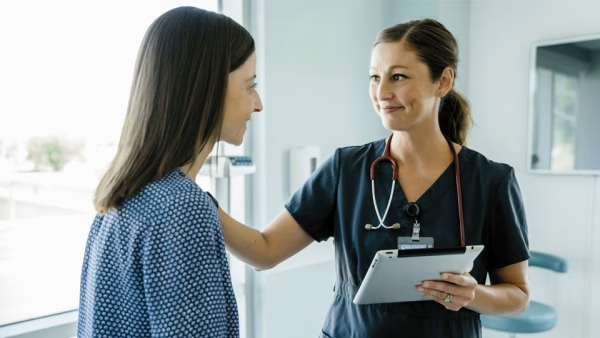5 things every woman should know about endometriosis
Endometriosis affects one in nine Aussie women


Most women have experienced the cramping and chocolate cravings that come with getting your period each month. But, for 176 million women across the globe, ‘period pain’ is a symptom of something far more serious.
Endometriosis.
Endometriosis is a common condition affecting one in nine Aussie women and, even more alarming, many women don’t even know they have endometriosis, because they put their pelvic discomfort down to period pain.
At its most serious, endometriosis can cause infertility. Fortunately, there are treatment options available and ways to reduce your risk of contracting the condition.
Related: How to perform a self-examination for breast cancer
1. What is endometriosis?
Endometriosis is a condition where tissue (called the endometrium) similar to that which lines the uterus starts growing elsewhere in the body, most commonly in the pelvis.
Around the time of your period, hormones are released which break down the tissue in the uterus so it can leave the body as menstruation. However when the endometrium growing outside the uterus breaks down, it has nowhere to go. It remains in your pelvic cavity, which over time can lead to inflammation, scarring, cysts and infertility.
It’s estimated that 30-40% of women with the condition will have difficulty conceiving, but it’s important to remember that treatment options are available and it may still be possible to get pregnant.
Endometriosis costs Australian women on average almost $4,000 in direct healthcare costs.
2. What are some signs you might have endometriosis?
The most common signs of endometriosis include painful periods, pelvic pain and pain during or after sex. Sufferers may also experience pain using their bowels and bladder, nausea and lethargy.
There is typically a delay of seven to 10 years between the onset of the condition and diagnosis. General Practitioner and nib Group Medical Advisor, Dr Hamish Black, says this may be as women normalise the pain.
“I think many women wouldn’t seek treatment, as they’d put that pain down to period pain. But because the biggest issue with endometriosis is potential infertility, if you’re concerned with symptoms, especially if they’re new to you, you should always get them reviewed,” says Hamish.
Many women with endometriosis experience pain so debilitating it can affect their ability to function. In fact, The Endometriosis Research Foundation Global Study of Women’s Health Consortium estimated that per year, endometriosis costs Australian women on average almost $8,000 in lost productivity and almost $4,000 in direct healthcare costs.
3. What causes endometriosis?
There is no known cause of endometriosis, although researchers believe genetics play a big role. Researchers at the Gynaecology Research Centre at the Royal Women’s Hospital have found that DNA and genes play a role in about 50% of cases.
It's also been hypothesised that immune system disorders can play a role, in that the body won’t recognise and eliminate endometrium cells outside of the uterus.
Another possible cause is retrograde menstruation, which is when some of the menstrual blood flows backwards into the pelvic cavity. Endometrial tissue in the blood may then continue to grow outside of the uterus.

4. How can you treat endometriosis?
There is no cure yet for endometriosis, however symptoms can be treated.
Pain management
You may decide with your GP to simply manage the pain with a non-inflammatory medication such as ibuprofen.
Allied treatments
Some women experience relief through complimentary therapies including massage, physiotherapy and psychology. At nib, we have a number of Extras covers that pay benefits towards these types of health services. And, if you’re already an nib member you’ll have access to our First Choice network of allied health professionals who have promised to deliver quality care and value for money for nib members. You can check exactly what your policy covers using member account.
Not with nib? You can get a quote for Extras cover in minutes online.
Hormone treatments
As oestrogen is known to encourage endometriosis, hormonal therapies aimed at reducing oestrogen may relieve some symptoms.
Surgery
Laparoscopy is keyhole surgery which can be used to both diagnose and treat endometriosis. It’s an option for women who want to conceive or for those who’s pain is so great that hormonal treatments are not effective. In some severe cases, your doctor may suggest a hysterectomy to remove the uterus.
There is no one right treatment for everybody, so it’s important to discuss your symptoms with your doctor. For example, a woman wishing to conceive may choose surgery, whereas for others, simple pain management might be more appropriate.
Reducing risk
Studies show that exercising for five hours a week reduces your risk of endometriosis recurring by 50%. Researchers at the European Society of Human Reproduction and Embryology also found that increasing your intake of fruit and vegetables can reduce your risk by up to 40%.
Minimising trans fats and including Omega-3 fats to your diet has also been shown to reduce inflammation and decrease the risk of endometriosis by 22%.
Diagnosing endometriosis can be difficult, however it’s important to tell your doctor if that’s what you’re concerned about.
5. Who should you go to for help?
As with any health concern, your GP should be your first port of call. Diagnosing endometriosis can be difficult, however it’s important to tell your doctor if that’s what you’re concerned about.
“It’s always important to state your concern when you go to the doctor and tell them what diagnosis you are worried you have. If you are wanting a referral for an opinion from a gynaecologist then you should state that,” says Hamish.
Your doctor will most likely want to rule out more serious illnesses before investigating endometriosis.
"If a woman had a change in her cycle or pelvic pain, we would do what we call a ‘differential diagnosis’. What that means is that if someone came in with those symptoms, you’d want to exclude other problems first, particularly cervical or uterine cancer,” says Hamish.
As it’s not always possible to diagnose endometriosis during an internal pelvic exam, your doctor may refer you to a gynaecologist. It’s important to know that you have options when it comes to your referral. Regardless of which specialist your GP names on your referral, you are able to choose to visit the specialist of your choice, so long as they’re in the same specialty field.
You may find after some research online that there’s a gynaecologist who has better patient reviews or offers shorter wait times than the one your GP included on your original referral. For more information on open referrals, check out our article: Can I take my referral to any specialist?
If you’re heading to your GP for a check-up, it could be a good opportunity to find out what other examinations you might be due for.
If you’re aged between 20-29, find out more with our article Health checks in your 20s.
If you’re aged between 30-39, we’ve put together this article: Health checks in your 30s.
Aged 40-49? There’s a dedicated article on The Check Up, Health checks in your 40s.
And, for the young-at-hearters (or those of us between 50-59), check out Health checks in your 50s.
Are you at risk of heart disease? 12 signs you need to know
We've put togther 12 risk factors for heart disease
Getting headaches? Here’s what you need to know about eye strain
Here are some tips on relieving your eye strain symptom from an optometrist.
8 healthy habits to start in your 30s
It's the perfect time to lay the foundations of good health
Written in partnership with
Dr Hamish Black
Dr Hamish Black has been a medical practitioner for more than 25 years. In addition to his role as nib group medical advisor, he still spends two days a week practising as a GP. He has spent many years working in emergency departments and in rural Australia, including a stint with the Royal Flying Doctor Service. Hamish also loves karaoke and dancing (though not that well at either, he says!), with Play that Funky Music by Wild Cherry being his karaoke favourite.





